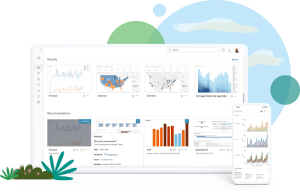Cloud communications services business, Sinch, used Tableau to accelerate the development of a data-centric culture.
Business growth always has positive connotations; however, it is not without complications. Sinch, the messaging and cloud communications (CPaaS) service provider, has acquired over 14 companies since its initial public offering (IPO) in 2015. This meant that it needed an effective way of analysing both its product portfolio and overall business performance across the entire organisation. The introduction of OneView not only solved this problem but also accelerated the adoption of a data-driven culture that is now spreading across the business and the many brands that have joined the family.
Stockholm-headquartered, NASDAQ-listed Sinch has a presence in 60 countries and its clients include telco giants AT&T, automotive leaders Toyota and Nissan, and Nespresso, the coffee capsule brand. “We deliver 600 billion engagements for 150,000 customers a year,” says Jennie Falk, Sinch Product Manager, Data & Analytics. “So, we create a lot of data.”
Five Steps Towards Creating a Data Culture
Establishing a data culture is essential for organisations to get the most from their data. Data insights enable better business decisions, more personalised customer communications, and greater automation.



Following the 2015 IPO, Sinch has been on an aggressive acquisition spree. “We have been buying firms for profitability, for increased global reach but also for the technology,” Falk says. The acquisition program made the business data far more complicated, which made the large Microsoft Excel spreadsheet Falk used to analyse the company’s performance unwieldy. “The product portfolio was growing, and these products were sold across all the different companies we had acquired. So, we had to bring data in from each firm, and we needed one way to track the main key performance indicators (KPI) for the whole company,” she says.
Looking for data and analytics technology, Falk said the fast-growing business required an application that was: “quick to set up.” This was essential as Sinch had a limited data and analytics team. “We needed to set up a data strategy to support the growth of the business,” she says.
One vision
“We put the OneView project together to create one place for all the KPI reporting, with Tableau as the interface,” Falk says. One of the organisations that Sinch had acquired was a Tableau user. Falk quickly realised that Excel spreadsheets were becoming too difficult to manage and create reports from, so she and Sinch adopted Tableau as the core data management platform for the business.
Falk still faced challenges as many of the organisations that Sinch acquired were, like Sinch, fast-growing businesses; they did not have a mature approach to data. Once again, Falk had to request Excel spreadsheets from the businesses, “so we had something to start with,” she says. “Most of the companies were small and didn’t have anyone dedicated to data, so we found someone in each business and asked for a file of the measures we needed, which were agreed upon by senior leadership.”
“Putting all these files together was rarely automatic and relied on people, so if a person left, losing access to the file was a real risk,” Falk says on tracking data before the OneView strategy was implemented. In addition, the fact that data was being pulled from so many different places in what had previously been different business meant there was a lot of inconsistency; “we really had to dig into the details and focus on the quality before we got the data set that we could work with,” she says on collecting the data and preparing it for analysis and reporting.
To avoid this situation repeating itself, Falk and Sinch have now embedded the Tableau tools into the Salesforce platform used by many of the Sinch companies. This enables the analytics team to enrich the data and better analyse conversion rates, for example. “Embedding the Tableau dashboards within Salesforce enables the business to access the data more easily,” Falk adds.
Despite the challenges, Falk says because Sinch began the OneView program as a small project with a clear scope, they overcame everything. Falk advises peers to involve stakeholders as early as possible, something she wishes she had done.
Sinch is now taking its OneView benefits to develop a data-centric culture across the business. “We have been engaging with our users via training and enabling self-service,” Falk says. “We are automating data flows as part of how we work to ensure people can access the data they need. To do this, we have changed the mindset of our users from wanting a table that they export from Tableau to Excel,” she says. This led to Falk’s team working more closely with colleagues to solve business issues using data. A critical part of data culture development at Sinch is the creation of a Tableau Community for the business.
“We have been improving the look and feel of our dashboards and adding explanatory text as our data is complex,” she says of how the data and analytics team is finessing the product to foster the data culture through ease of use. “You cannot be too clear, and you cannot have too much explanation on your dashboards.” Falk says developing a data culture is “about handling people as much as it is handling data.”
Learn how other Tableau customers have developed Tableau Communities.
The world’s leading analytics platform
Tableau is the broadest and deepest, end-to-end data and analytics platform. Ensure the responsible use of data and drive better business outcomes with fully integrated data management and governance, visual analytics and data storytelling, and collaboration—all with Salesforce’s industry-leading Einstein built right in.

























